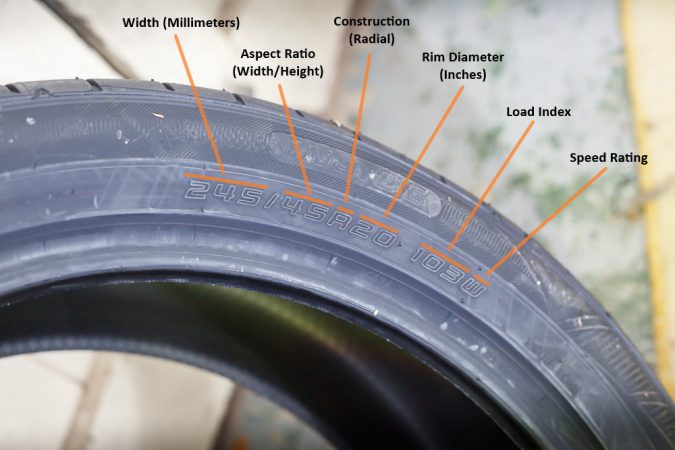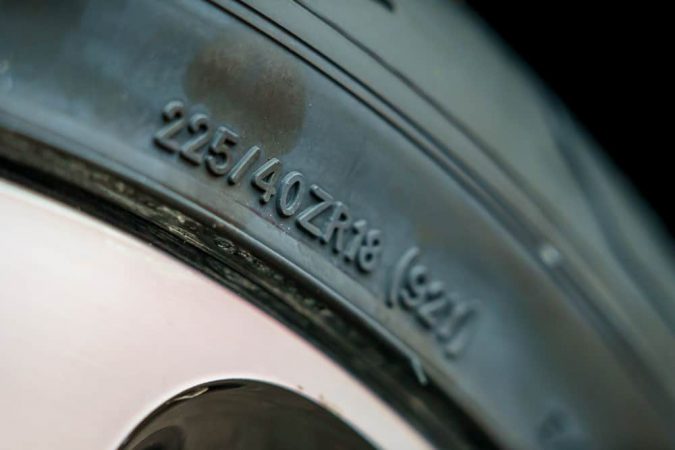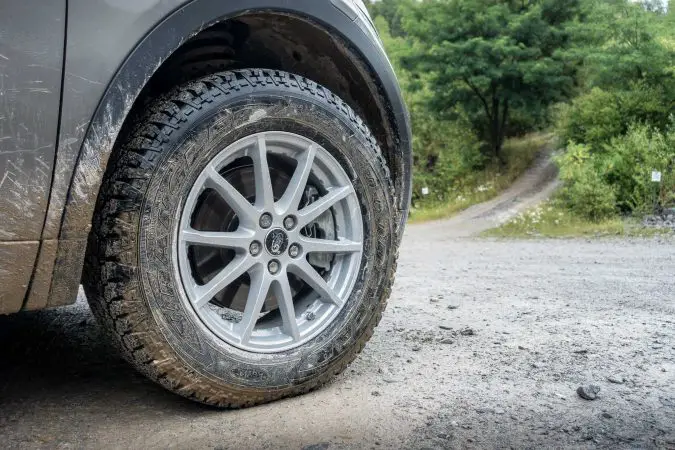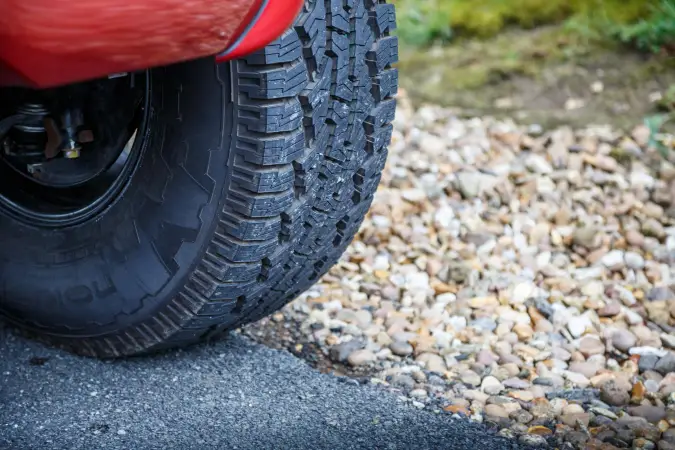Unlike most components on your car, it’s quite easy to find and identify the specifications of the tires. Crouch down, and you can readily spot a tire’s particulars with a series of numbers and letters. These could help you figure out what size it wears, or even the speed it can handle. However, while jotting this down may be simple, trying to understand things like tire load range SL can be confounding.
So, what does this mean, exactly? Moreover, how can you read a tire’s load range, and is it the same as the “load index” that you might’ve heard at your local tire shop? We’ve written a thorough guide not too long ago that details a complete tire size chart. The one thing we didn’t mention, which is rarely seen outside most passenger cars, is how much a tire load range SL can take in its day-to-day use.
While it may seem trivial at first, learning more about tire load range SL is crucial to ensure both the safety of your person, as well as your vehicle. In layman’s terms, your tire’s load range is what alerts you of the maximum weight it can safely handle. It’s especially important in commercial vehicles like trucks, which often need to ferry around a lot of haulage. So, here’s all that you need to know…
- What Is Load Range?
- The Same As Load Index?
- How To Read Them
- Where Can You Find It?
- What Do The Letters Mean?
- Load Index Chart
- SL Versus XL Tires
- Final Thoughts
What Is A Tire’s Load Range?
Before we get any deeper into tire load range SL, let’s discuss what tire ‘load range’ is, in general. As we mentioned earlier, tire load range is a measurement of how much weight your vehicle can safely carry, within the tire’s limits. Remember that your tires are what’s ultimately making contact on the road. Therefore, your vehicle’s driveability will be limited to how much your tires can take.
For instance, there’s a good reason why a Bugatti Veyron’s tires will cost you a whopping $42,000 for a single set. With 1,000hp on tap, it can hit an awe-inspiring top speed in excess of 250mph. This is otherwise impossible for regular road-going tires to achieve. At that speed, there’s much load, heat, pressure, and friction, that your everyday tires would experience a blow-out. Hence, why load range matters.
Among other variables that detail a tire’s limits, load range determines the tire’s ability to hold its air, and your vehicle’s entire weight. It’s based on something that used to be called “ply rating”. As we’ll try to understand that, you’ll first have to get to grips with the fact that rubber isn’t the only material that a tire is made of. Inside, there are layers of metal and fibers held together, known as ‘plies’.
These plies, and depending on how many of them are there, form a key part of your tire’s structural integrity. Nowadays, sophisticated tire design has allowed us to sport meatier tires without using as many plies as it once did in the past. Even two plies inside a modern tire can handle as much weight as a six-ply tire from a few decades ago. The more plies a tire has, the more load it could handle.
Is A Tire’s ‘Load Range’ The Same As Its ‘Load Index’?
Given the similarities in naming, many often confuse and interchangeably use ‘load range’ with ‘load index’. Nevertheless, while they may share some similarities in their definition, both don’t denote the same thing.
- Load Index – Specifically, the load index is a measurement of the maximum weight a tire can carry at a time. Once you’ve inflated your tires up to their maximum recommended pressure (PSI), its load index can let you know the limit for carrying capacity. Similar to load range, the higher the load index, the more mass you could lug around safely. Nonetheless, it can only tell you the weight, nothing more.
- Load Range – Compared to just the weight limit of a vehicle’s carrying capacity that’s sustained at its suggested PSI pressure readings, load range describes more of a tire’s durability. It combines data on how much air it can hold in or the amount of mass (or weight) it can haul around. Crucially, it could also inform you if the tire is built with a reinforced structure, which would be handy for heavy trucks.
Referring back to our earlier explanation on ply ratings, this is where load range comes in. Note, that in some cases, load range might also be called ‘load rating’ or ‘load capacity’, while the old standard of ‘ply rating‘ could still be used today. Once again, ply count doesn’t matter much on modern tires. These days, load range defines a tire’s solidness, as well as maximum permissible air pressure.
How Can You Read Your Tire’s Load Range?
We now come to the question of how can you read if it’s a tire load range SL, or not? You can refer to our old tire size chart if you’d like to know more about how you could read the sidewall markings. It’s worth checking out if you’re keen to understand what they all mean. We didn’t, mind you, remark on tire load ranges, as it’s uncommon to find them on most tires. Still, we did guide you on load indexes.
Here’s a quick refresher, based on the same example we used back then. Typically, your sidewall will display markings such as P 245/45 R20 103W
If we break it down, we can read it more simply as:
- P – The type of tires, with ‘P’ standing for ‘passenger vehicles’, and is the most common fitment ranging from small hatchbacks to medium-duty pickups.
- 245 – Width of the tires, measured from the sidewall to the inner sidewall, in millimeters (25.4mm is for 1 inch).
- 45 – Aspect ratio, detailing the thinness of the tire’s sidewall or profile is. 45 mean that the sidewall is 45% of the width, dimensions-wise.
- R – Construction, or what type of tire you have fitted onto your car. R is the most common, standing for Radial-type tires.
- 20 – Wheel diameter, or you might say alloy or rim. We also have a guide on this, concerning how to read rim sizes. 20, now measured in inches, means that you need 20-inch rims.
- 103 – This here is the load index that we mentioned earlier, specifying how much weight the tires can carry without difficulty. 103 is a bit higher up the chart than most other tires.
- W – Speed rating, where the letter determines how much speed (in mph), your tires can safely take on.
Why Isn’t Your Tire’s Load Range On The Sidewall?
With all that in mind, what about the load range? Where’s the tire load range SL at? Well, the set of tires we used for this example are road-going passenger tires. Usually, tires made for regular vehicles like sedans, hatchbacks, crossovers, compact to medium-sized SUVs, minivans, and light to medium-duty pickup trucks don’t display the load range. Simply put, it’s not that important for them.
These types of vehicles don’t typically carry that much weight anyway. Thus, they often sport a set of 4-ply tires, which are sufficient enough given their usual load capacity. As they don’t need that extra load-carrying capacity, their regularly reinforced tires are unmarked as far as load range goes. With that being said, some heavier duty vehicles, such as commercial trucks, would always include it.
On the sidewall, the load range is generally found near the end of the markings. Using our example, it may read as “P 245/45 R20 103W SL”. Or, some tires might imprint the whole text, just to be more clearer, such as “P 245/45 R20 103W Load Range SL”. Meanwhile, others would include a forward slash in front of the load range reading, like “P 245/45 R20 103W/SL”. In all, the letter is what’s important.
To be more specific, the load range will only appear as letters. As to what they mean, you’ll have to refer to a chart for a precise measurement of its ply count, and maximum air pressure at the full load as specified by the ‘load index’. In the end, both the load range and load index must be accounted for when you’re shopping for a set of tires that can comfortably support your vehicle’s full weight.
What Do The Letters In A Tire’s Load Range Mean?
While we’re at it, it’s worth getting into knowing the various load ranges available for most tires you can find on the market today. This includes tire load range SL, which is commonly found on what we refer to as “P-metric tires”. Or, tires designed for passenger-based vehicles, which we’ve explained as that letter ‘P’ that appears at the front of the sidewall markings. So, here goes…
1. Passenger-Type Tires – Tire Load Range SL, LL, And XL
As we spoke earlier, passenger (or ‘P’ marked) tires don’t often carry any additional markings for the load range on the sidewall. Although, you might come across these 3 markers:
| Load Range | Markings | Max Load Pressure |
|---|---|---|
| Light Load | LL | 35psi (240kPa) |
| Standard Load | SL (Or Unmarked) | 35psi (240kPa) |
| Extra Load | XL | 41psi (280kPa) |
If you don’t see any markings on your sidewall, you likely have a tire load range SL. If not, LL or XL might appear, for tires designed to operate at lower or higher loads pressures, respectively. It has to be noted though, that only tires whose aspect ratio is 45% is lower can carry a light load (or LL designation). Moreover, it’s possible that tire load ranges might change in formatting in the future.
To better standardize tire load range worldwide, the US will be adopting ISO and European style load range measurements. These would change the max load pressure to 36psi and 42psi, accordingly. It might not affect the LL, SL, or XL denotations, though. You can expect this change to take place with some newer tires on the market already. So, be wary of how much pressure it can actually support.
2. European-Style Passenger-Type Tires – Tire Load Range SL And RF (or XL)
For our European friends, on the other hand, they also have a similar system in place to measure the load rating or capacity of a tire. If you can’t see any markings, it’s also likely an SL-rated tire. Apart from that, you might notice:
| Load Range | Markings | Max Load Pressure |
|---|---|---|
| Standard Load | SL (Or Unmarked) | 36psi (250kPa) |
| Extra Load (Or Reinforced) | XL (Or RF) | 42psi (290kPa) |
The terms ‘extra load’ and ‘reinforced’ are generally used interchangeably. Just like US-style SL-rated tires, they both discern heavy-duty tires. XL (or RF) in either European or American nomenclature can be found on more than just commercial or off-road tires, too. As they define the general robustness of a tire, XL or RF could be spotted on racing and competition cars that require track-capable tires.
3. Light Truck Tires – Load Ranges B, C, D, E, F (And More)
Just as how you can find the letter ‘P’ at the very front of your sidewall readings, you might also spot the letters ‘LT’ there, instead. LT-metric tires are roughly defined for light trucks. A step above the P-metric tires, LT-type tires can usually handle more load. As such, you can find the LT designation on large SUVs, heavy-duty pickups, as well as commercial freighters, semi-trucks, or even buses.
Unlike P-metric tires, LT tires can sometimes be more specific with their measurements. You might be able to notice mentions of the ply count in there, as well as maximum supported load (in lbs). Here is a list of the most popular load range abbreviations found on LT-metric tires:
| Load Range | Ply Rating | Markings | Max Load Pressure (≤ 11.5-Inch Or 295mm Wide Tires) | Max Load Pressure (> 11.5-Inch Or 295mm Wide Tires) |
|---|---|---|---|---|
| B | 4 | B | 35psi (240kPa) | – |
| C | 6 | C | 50psi (350kPa) | 35psi (240kPa) |
| D | 8 | D | 65psi (450kPa) | 50psi (350kPa) |
| E | 10 | E | 80psi (550kPa) | 65psi (450kPa) |
| F | 12 | F | 95psi (650kPa) | 80psi (550kPa) |
It’s also worth mentioning that some LT-type tires have modified maximum load pressures that don’t correspond with these standardized measurements. Therefore, you should be wary as to how much weight it can take on. As highlighted earlier, commercial-grade or heavy-duty tires would often have the exact max load pressure marked onto the sidewalls. This way, you can check it more easily.
4. Light Truck Tires – Expanded Load Range Chart (Based On Ply Ratings)
Although the chart up above for LT-metric tires is the most commonly-adopted standard, you might come across a tire that carries an additional suffix. This alphanumeric nomenclature could sport an additional ‘1’ or ‘2’ notation next to the letters. For example, there are C1 load range tires, as well as C2. On the surface, they both have the same ply rating, and maximum supported weight.
However, C1 (or most other ‘1’ suffixed tires) have a higher permissible maximum pressure compared to C2. Here’s a quick chart of how to make sense of them:
| Load Range | Ply Rating | Max Load Pressure |
|---|---|---|
| C1 | 6 | 50psi (350kPa) |
| C2 | 6 | 35psi (240kPa) |
| D1 | 8 | 65psi (450kPa) |
| D2 | 8 | 50psi (350kPa) |
| E1 | 10 | 80psi (550kPa) |
| E2 | 10 | 65psi (450kPa) |
| F1 | 12 | 95psi (650kPa) |
| G | 14 | 110psi (760kPa) |
5. Special Trailer Tires – Load Ranges B, C, D, And E
Besides P-metric and LT-metric tires, you may also find ST-designated ones, as well. Here, ‘ST’ stands for ‘special trailer’. You’ll find these letters on tires made for actual trailers, not vehicles. An example would be those tires fitted onto towed motorhomes or campers. Or, you’ll find ST tires on trailers for carrying your boat, utility-type trailers, or even the fifth wheel of your RV.
In any case, special trailer tires also have their own load ranges. On the sidewall, you might notice an ‘LR’ prior to the actual load range abbreviation of B to E, such as “… LRE”. LR is short-form for “Load Range’. So, you’ll spot these as, ‘LRD’, to define ‘load range D’ tires, right at the end of the sidewall readings. Here’s a chart for load ranges on ST-metric tires:
| Load Range | Ply Rating | Markings | Max Load Pressure |
|---|---|---|---|
| B | 4 | B | 35psi (240kPa) |
| C | 6 | C | 50psi (350kPa) |
| D | 8 | D | 65psi (450kPa) |
| E | 10 | E | 80psi (550kPa) |
How To Pair Tire Load Range SL With Load Index?
Remember, load range isn’t enough on its own to make you aware of the maximum weight a vehicle can be supported by its tires. You’ll also have to bear in mind its load index. Here’s a quick and easy load index chart that you can reference, taken from our previous guide on tire size charts:
| Index | Load (lbs) | Index | Load (lbs) | Index | Load (lbs) |
|---|---|---|---|---|---|
| 65 | 639 | 94 | 1,477 | 123 | 3,417 |
| 66 | 661 | 95 | 1,521 | 124 | 3,527 |
| 67 | 677 | 96 | 1,565 | 125 | 3,638 |
| 68 | 694 | 97 | 1,609 | 126 | 3,748 |
| 69 | 716 | 98 | 1,653 | 127 | 3,858 |
| 70 | 739 | 99 | 1,709 | 128 | 3,968 |
| 71 | 761 | 100 | 1,764 | 129 | 4,079 |
| 72 | 783 | 101 | 1,819 | 130 | 4,189 |
| 73 | 805 | 102 | 1,874 | 131 | 4,299 |
| 74 | 827 | 103 | 1,929 | 132 | 4,409 |
| 75 | 853 | 104 | 1,984 | 133 | 4,541 |
| 76 | 882 | 105 | 2,039 | 134 | 4,674 |
| 77 | 908 | 106 | 2,094 | 135 | 4,806 |
| 78 | 937 | 107 | 2,149 | 136 | 4,938 |
| 79 | 963 | 108 | 2,205 | 137 | 5,071 |
| 80 | 992 | 109 | 2,271 | 138 | 5,203 |
| 81 | 1,019 | 110 | 2,337 | 139 | 5,357 |
| 82 | 1,047 | 111 | 2,403 | 140 | 5,512 |
| 83 | 1,074 | 112 | 2,469 | 141 | 5,677 |
| 84 | 1,102 | 113 | 2,535 | 142 | 5,842 |
| 85 | 1,135 | 114 | 2,601 | 143 | 6,008 |
| 86 | 1,168 | 115 | 2,679 | 144 | 6,173 |
| 87 | 1,201 | 116 | 2,756 | 145 | 6,393 |
| 88 | 1,235 | 117 | 2,833 | 146 | 6,614 |
| 89 | 1,279 | 118 | 2,910 | 147 | 6,779 |
| 90 | 1,323 | 119 | 2,998 | 148 | 6,944 |
| 91 | 1,365 | 120 | 3,086 | 149 | 7,165 |
| 92 | 1,389 | 121 | 3,197 | 150 | 7,385 |
| 93 | 1,433 | 122 | 3,307 |
Effects Of Load Index Across Other P-Metric Tires
There are a couple of additional caveats that we have to tie into this. Load index is rated on a tire-to-tire basis. In other words, how much weight can a single tire manage on its own? To get an accurate load index reading for the entire car, simply multiply the load index by how many tires you have. For example, let’s reference our earlier sample of 103 load index tires, which can support 1,929lbs.
For 4 tires, that would be 1,929lbs x 4, which equates to 7,716lbs. This is the maximum load that the vehicle in question can carry. In addition, you also have to be diligent about its fitment. P-metric tires can support 100% of the load index if fitted on passenger cars. To be specific, sedans, hatchbacks, or smaller crossovers. This is reduced to 91% if mounted on light to medium-duty trucks, or SUVs.
That 9% reduction has to be factored in to account for their higher center of gravity, as well as their potential to be overloaded with mass. As one does when hauling things in a pickup, for instance. As a result, our 7,716lbs load index earlier may be true for a passenger car. But on a heavier truck or SUV, it’s more like 7,022lbs, once you remove 9% from the final load index reading.
Which Is Better, Tire Load Range SL, Or XL?
One decision that many people have to make (and often compromise over), is whether to pick SL or XL load range tires. With Extra Load (XL) tires, and as our earlier explanation suggests, carry more reinforced internal structures. This usually comes down to using plies made of harder materials or adding more plies on top of the existing ones. The result is improved strength in the tires overall.
Furthermore, it could help minimize tire deflection, as well as mitigate any potential damage caused by impact. Hence, why XL tires are a popular fitment for race cars and off-roaders alike. They’re able to withstand loads at higher speeds or on rougher terrain, and the pressure of the mass that they carry. If you’re struggling to pick one or the other, here’s a quick guide to help you decide:
Primary Features Of Tire Load Range SL:
- They’re more fuel-efficient, since they’re smaller and lighter than XL tires, hence making them easier to rotate.
- Cost-effective, owing to how simpler tire load range SL construction is, and are generally cheaper if compared to XL-range tires.
- SL-range tires, as they’re less cumbersome to drive on, are often best for day-to-day commuting and driving.
Primary Features Of Tire Load Range XL:
- Reinforced internal structure makes it capable of carrying greater load pressure, ensuring that you’re able to carry additional passengers or cargo easily.
- Can withstand shock and damage far better than SL-grade tires, which could result in them lasting a lot longer than XL tires.
- Although much more expensive, XL tires and their improved ruggedness, durability, and reliability are a perfect fit for heavy-duty or high-performance vehicles.
Tire Load Range Facts:
- A tire’s load range indicates the amount of load it can safely carry at the pressure specified by the manufacturer.
- The tire load range SL pertains to the maximum weight an SL-rated tire can safely carry, which is primarily designed for passenger cars.
- Standard Load or SL tires have a load capacity suitable for their tire size and can bear weight up to 35 psi.
- SL tires lack reinforcements and are not ideal for towing or off-road use, and have the potential for damage or reduced lifespan.
- SL tires are typically made with two plys and lack the added reinforcements found in XL tires, which provide greater resilience to damage.
- XL and SL tires of the same size differ in that XL tires can be inflated to higher pressure, increasing the tire’s load capacity, while SL cannot.
- Passenger tires or SL tires are less costly than light truck tires, but light truck tires are required for heavy-duty work, such as in a 1-ton pickup truck.
- Heavy-duty tires are required for larger vehicles such as trucks, and SL tires are not designed for such heavy-duty functions, and can thus be hazardous.
- Light truck or LT-metric tires are commonly used as Original Equipment tires for consumer trucks, especially larger ones.
- LT-metric tires have more rigid sidewalls and stronger construction, intended to endure the significant weight of a fully laden rig and possibly harsh towing demands and provide greater control over the vehicle under load.
Final Thoughts On Tire Load Range SL
That then is a great place to wrap up our guide here on tire load range SL. We’ve learned so far that tire load range SL has been rated to sustain a maximum load pressure of 35psi. Combined with your load index, you should have a better idea of how much weight (and load) your tires can safely carry. While it might seem like a footnote to most people, picking out the right tires is worth learning.
Wrongly sized and poorly-fitted tires can lead to extensive wear and tear. This won’t just cost in the long run as you’re more frequently swapping out tires. Moreover, incorrect fitment can lead to poor performance, as well as an adverse impact to fuel economy. Worse, tires that can’t sustain too much weight at high loads might even blow out in the middle of a drive, which can prove deadly.








